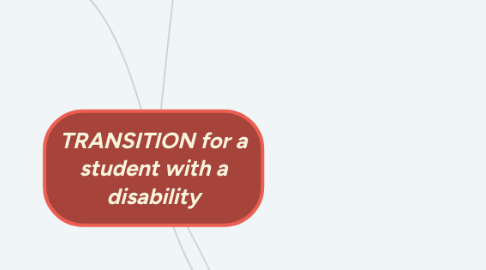
1. is REQUIRED to
1.1. include
1.1.1. follow these IDEA regulations
1.1.1.1. anyone involved in the student’s transition plan must be invited
1.1.1.2. Local educational agencies must provide students with a summary of the student's academic achievement and functional performance
1.1.2. in the IEP
1.1.2.1. a statement of needed transition services no later than 16 years of age
1.1.2.2. include a statement of student's transition goals and services
1.1.2.3. instruction
1.1.2.4. – related services
1.1.2.5. – community experiences
1.1.2.6. – development of employment and other post-high school adult living objectives
1.1.2.7. – acquisition of daily living skillsand functional vocational evaluation if appropriate
1.1.2.8. transition assessment and future goals
2. is IMPORTANT because
2.1. Over 30% of children with learning disabilities drop out of high school.
2.2. Only 13% of students with learning disabilities (compared to 53% of students in the general population) have attended a 4-year post-secondary school program within two years of leaving high school.
3. is DEFINED as
3.1. a required plan, or coordinated set of activities, for a student with a disability that.....
3.1.1. is
3.1.1.1. designed within an outcome oriented process
3.1.1.1.1. that
3.1.1.2. based on the student's
3.1.1.2.1. needs
3.1.1.2.2. preferences
3.1.1.2.3. interests
3.1.1.2.4. strenghts
4. is PLANNED BY
4.1. an IEP team consisting of
4.1.1. student
4.1.1.1. communicates
4.1.1.1.1. preferences
4.1.1.1.2. interests
4.1.1.1.3. strengths
4.1.1.1.4. areas of need
4.1.1.1.5. types of support needed
4.1.2. parent/guardian
4.1.2.1. provides
4.1.2.1.1. support for the student
4.1.2.1.2. info about the student's
4.1.2.1.3. active engagement in planning, discussions, and decision making
4.1.2.1.4. opportunities for the child to practice adult roles and responsibilities
4.1.3. special education teacher
4.1.3.1. provides
4.1.3.1.1. information about the student's
4.1.3.1.2. assistance to student in identifying post secondary goals
4.1.3.1.3. student progress monitoring assistance
4.1.3.1.4. input on IEP
4.1.4. LEA representative
4.1.4.1. provides
4.1.4.1.1. support for special and general education staff
4.1.4.1.2. info about programs in the school system and community
4.1.4.1.3. necessary resources, including technology, accommodations, and supports
4.1.5. general education teacher
4.1.5.1. assists
4.1.5.1.1. planning courses of study in general education curriculum
4.1.5.1.2. student with identifying post secondary goals
4.1.5.1.3. in identifying and providing positive behavioral strategies and interventions
4.1.5.1.4. student progress monitoring
4.1.6. evaluation interpreters
